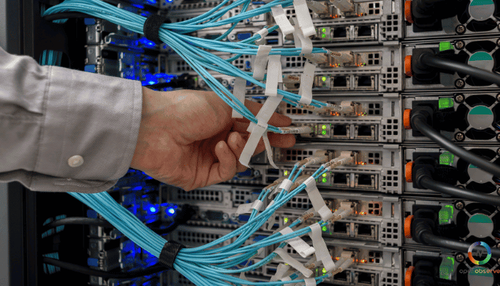
As the volume of data generated by applications and systems continues to skyrocket, log analysis has become a critical tool for modern businesses. Companies today aren't just focused on storing vast amounts of data—they need actionable insights in real-time to ensure operational efficiency and maintain security. The rise in cybersecurity threats and compliance regulations has only intensified the need for robust log analysis to track system health, detect anomalies, and respond to issues before they escalate.
Organizations that rely on microservices, cloud infrastructure, or large-scale distributed systems need real-time insights to keep their services running smoothly. Whether it's uncovering hidden performance bottlenecks or safeguarding sensitive data, log analysis plays a pivotal role in keeping businesses secure and efficient.
This blog will explore the key benefits of log analysis, how it works, and the tools shaping the future of log management.
Log Analysis Overview
Log analysis is the process of reviewing, interpreting, and understanding log data generated by applications, systems, and network devices. This process helps uncover crucial insights into how systems perform, identify security threats, and troubleshoot operational issues. In essence, it turns raw log data into actionable information.
The purpose of log analysis is to monitor system health, improve security posture, and ensure compliance with industry regulations. By analyzing logs, organizations can track user activity, detect anomalies, and respond to incidents in real time. It's not just about finding problems; it's about understanding trends and optimizing systems for better efficiency.
However, despite its benefits, log analysis comes with challenges. One of the biggest hurdles is aggregating massive amounts of log data from multiple sources. With modern applications relying on distributed systems, gathering, centralizing, and formatting these logs for analysis can be complex. Additionally, ensuring that this data is useful and actionable while avoiding "noise" is another key challenge teams face.
Importance of Log Analysis
Log analysis plays a vital role in maintaining operational efficiency, security, and overall system performance. As organizations grow, the need for real-time insights into various aspects of their IT infrastructure becomes critical. Let’s break down why log analysis is so important across multiple areas:
- Regulatory Compliance: Many industries, such as finance and healthcare, have strict data handling and privacy regulations. Analyzing logs helps businesses stay compliant by ensuring that access to sensitive data is monitored and documented. It’s a proactive way to meet audit requirements and avoid penalties.
- Security Enhancements: Cybersecurity threats are on the rise, and log analysis offers a defense by helping detect anomalies, track suspicious activity, and identify security vulnerabilities in real time. Monitoring logs can also aid in detecting intrusions or data breaches, allowing businesses to respond promptly and minimize damage.
- Efficiency Improvements: By studying logs, teams can identify performance bottlenecks and optimize system resources. This process leads to more streamlined operations, reducing downtime and improving the user experience. It’s a powerful tool for boosting overall efficiency within IT environments.
- High Availability: Logs provide critical insights into system availability, helping organizations quickly identify and resolve issues that could lead to service outages. Log analysis supports the goal of achieving high availability in any business environment by ensuring that systems remain operational.
- Resource Allocation: With insights from log data, businesses can make informed decisions about resource allocation. For example, analyzing logs can reveal whether certain resources are being underutilized or overburdened, helping teams optimize infrastructure and reduce unnecessary costs.
- Sales and Marketing Effectiveness: Beyond IT operations, log analysis also benefits sales and marketing teams by providing insights into user behavior. Tracking interactions on websites, apps, and platforms helps these teams understand customer preferences, improve targeting strategies, and enhance overall campaign effectiveness.
Log analysis serves as a strategic tool, enabling organizations to stay compliant, secure, and efficient across various areas of operation. Now, let’s take a closer look at how log analysis works and the key processes involved in transforming raw log data into actionable insights.
How Log Analysis Works
Log analysis follows a structured process to transform raw log data into actionable insights, allowing teams to identify performance issues, security threats, and areas for optimization. Below is a step-by-step breakdown of how this process typically works.
1. Data Collection
The first step in log analysis is gathering log data from various sources, such as servers, applications, firewalls, and databases. With modern IT environments becoming more distributed, this often involves collecting data from cloud services, on-premises systems, and containers. For instance, log data might be collected from multiple clusters in real-time in Kubernetes-based systems.
As data sources grow, maintaining consistent collection across environments can become complex. Distributed systems, in particular, need robust log collectors that ensure no data is lost during transfer or crashes.
Read more about Harnessing the Power of FluentBit to Stream Kubernetes Logs to OpenObserve!
2. Data Indexing and Centralization
Once the data is collected, it must be indexed and centralized for efficient storage and retrieval. Indexing helps speed up search queries by structuring the log data to make it easy to filter and analyze. Centralization typically involves aggregating logs from multiple sources into a single location, such as a log management platform like ELK Stack or OpenObserve.
Example: In a cloud-based infrastructure, centralizing logs from distributed containers and microservices requires the data to be pushed into a central platform. For instance, OpenObserve provides the infrastructure to store and index logs, ensuring faster and more reliable access to logs from various microservices.
3. Data Parsing and Formatting
Before analysis can begin, the raw log data needs to be parsed and formatted into a structured format like JSON, making it easier to interpret. Log data is filtered during this step, and unnecessary noise is removed. Parsing also involves mapping various log formats into a standard one to ensure uniformity across all sources.
In systems where multiple applications are logging data, parsing helps standardize logs that may have different structures, ensuring the analysis isn't hindered by inconsistent formats. Tools like OpenObserve can be used to streamline this process by acting as an intermediary between log sources and central storage, simplifying the collection, parsing, and visualization of logs.
Read more on how to Filter logs at source in otel collector
4. Search and Analysis
After the data is formatted and indexed, teams can search and analyze logs to identify patterns, troubleshoot issues, or uncover inefficiencies. Most modern log analysis tools provide search capabilities that allow you to filter logs by specific time periods, events, or error codes.
Advanced platforms like OpenObserve offer powerful query languages similar to PromQL in Prometheus, enabling developers to conduct detailed log analysis. This helps in finding specific events, correlating metrics, and investigating anomalies.
Read more on How to capture AWS VPC Flow Logs and analyze them
5. Monitoring and Alerts
Many log analysis systems include monitoring and alerting features to ensure real-time observability. Alerts can be configured to notify teams when specific thresholds are reached or when anomalous behavior is detected in the logs.
For instance, if a web application is experiencing an unusually high number of 500 errors, a well-configured alerting system will notify the DevOps team immediately. The log data can then be analyzed to determine the root cause of the issue, such as a failing microservice.
6. Reporting
Lastly, log analysis often culminates in detailed reports that summarize key insights. These reports help stakeholders understand performance, security, and operational efficiency. Visualizations like dashboards, charts, and graphs further enhance the accessibility of log data, allowing both technical and non-technical teams to derive value from it.
Example: An e-commerce company might generate weekly reports summarizing key logs, such as user behavior logs, security incidents, and server uptime. This helps guide decisions about scaling infrastructure, improving user experience, or patching security vulnerabilities.
By understanding each step in the log analysis process, you can fine-tune your approach to ensure your systems are running at peak performance. Now, let’s delve into some more advanced techniques that take log analysis to the next level.
Advanced Log Analysis Techniques
As organizations handle increasing data, advanced log analysis techniques are essential for sifting through large log volumes and extracting meaningful insights. Here’s how these techniques work:
1. Normalization
Normalization ensures that data from different sources follows a consistent structure. For example, in e-commerce platforms, logs from different systems like payment gateways, inventory management, and customer support are standardized to provide a unified view of system activity. This consistency allows for smoother data analysis, ensuring nothing is lost in translation due to varied formats.
2. Pattern Recognition
Pattern recognition involves identifying recurring sequences or behaviors within logs. Financial institutions use this technique to detect fraud, such as identifying unusual transactions or access patterns that deviate from the norm. Similarly, in network monitoring, abnormal traffic patterns could signal potential security threats. By detecting anomalies early, businesses can take preventive actions before incidents escalate.
3. Classification and Tagging
Log data can be categorized based on predefined tags, making it easier to identify specific issues. For instance, a cloud service provider can classify logs into error types, such as HTTP 500 errors or network timeouts, which helps pinpoint problem areas quickly. This technique is especially useful in large-scale systems where logs can span thousands of lines.
4. Correlation Analysis
Correlation analysis connects seemingly unrelated log entries to uncover patterns or trends. In IT operations, correlation analysis can reveal how a database slowdown affects the front-end user experience. For example, in a SaaS company, slow query response times from a database might lead to increased user drop-offs, which can be traced back to the source using this method.
5. Artificial Ignorance
Artificial ignorance filters out known, irrelevant log entries, allowing teams to focus only on critical events. For example, in a manufacturing setting, repetitive logs indicating successful operations can be ignored, while rare errors that might indicate machine malfunctions are brought to the forefront. This helps operators concentrate on actual issues rather than sifting through noise.
These advanced techniques significantly boost operational efficiency across industries. Financial services use pattern recognition for fraud detection, while e-commerce platforms rely on correlation analysis to optimize performance and detect bottlenecks in real time.
By applying these methods, businesses can maximize the effectiveness of their log analysis and gain valuable insights to improve security, performance, and overall operational health.
Next, let’s explore the key tools that make these techniques possible.
Popular Log Analysis Tools
Choosing the right tool for log analysis can significantly impact the effectiveness of monitoring, troubleshooting, and system optimization. Here’s a look at some of the top solutions available, starting with OpenObserve, a comprehensive platform designed to go beyond logs by incorporating metrics and traces.
1. OpenObserve
OpenObserve offers robust log analysis capabilities along with built-in support for metrics and traces, making it a comprehensive observability platform. It’s ideal for teams that require deeper insights into system health and performance.
With real-time monitoring, alerting, and powerful search functions, OpenObserve provides a unified view of logs, ensuring seamless integration with microservices and cloud-native environments. Whether you're scaling applications or identifying security vulnerabilities, OpenObserve has you covered.
Sign up for OpenObserve today.
2. Splunk
Splunk is one of the most popular log analysis tools, offering powerful data collection, search, and visualization features. Known for its scalability, Splunk provides enterprise-grade solutions for real-time analytics, making it suitable for large organizations with complex systems. Its built-in machine learning tools also allow users to predict and prevent system issues.
3. ELK Stack (Elasticsearch, Logstash, Kibana)
The ELK Stack is a widely adopted open-source solution that excels in centralized log management. Elasticsearch handles the search and indexing, Logstash processes and transforms logs, and Kibana offers visualization capabilities. This trio works in harmony to offer a flexible, scalable platform for log analysis, suitable for companies of any size.
4. Dynatrace
Dynatrace offers AI-powered log monitoring, giving you real-time insights into application performance, security vulnerabilities, and system anomalies. It’s designed to work seamlessly in cloud environments and comes with built-in automation for incident management and performance optimization.
5. Logmind
Logmind focuses on real-time log analysis and anomaly detection. Using AI-driven insights, Logmind helps detect irregularities in log patterns, providing actionable insights for troubleshooting and performance improvements. Its cloud-native architecture makes it particularly suited for modern SaaS applications.
6. Datadog
Datadog is known for its real-time monitoring and security capabilities, and it offers log management as part of a broader observability platform. Its ability to correlate log data with metrics and traces makes it a valuable tool for understanding complex, distributed systems.
7. LogicMonitor
LogicMonitor offers a fully automated log analysis solution with real-time alerts and dashboards. It excels in performance monitoring and can track logs from multiple data sources, making it ideal for infrastructure monitoring across various environments, including hybrid clouds.
8. Graylog
Graylog is another popular open-source log management tool that provides real-time logging and analysis. Its simplicity and flexibility make it a go-to for teams needing scalable log management solutions. With a user-friendly interface and powerful search capabilities, Graylog can be easily integrated into existing IT workflows.
9. Logit.io
Logit.io is designed to provide managed ELK and Grafana services, making it a good option for teams that want the power of the ELK stack but without the hassle of managing it. Its fully managed service ensures a smooth log analysis experience, particularly for organizations looking to simplify infrastructure management.
10. Sematext Logs
Sematext Logs is a log management and analytics platform with real-time alerts and anomaly detection. Its key strength is its ability to integrate with multiple data sources, making it easy to centralize logs from various services and applications. Sematext also offers a comprehensive monitoring suite for infrastructure and application performance.
These tools each have their strengths, and choosing the right one depends on your specific needs—whether it's scalability, ease of use, or the ability to integrate with other systems. Tools like OpenObserve not only provide extensive log analysis capabilities but also enable full observability across logs, metrics, and traces, ensuring comprehensive monitoring and troubleshooting.
Choosing the Right Log Analysis Tool
Selecting the right log analysis tool can be daunting, especially considering the wide range of options available. To ensure you're making the best choice, it's important to consider key factors that go beyond basic functionality.
1. Factors to Consider
When choosing a tool, the first thing to evaluate is its compatibility with your existing infrastructure. If you're operating in a hybrid cloud environment, integration issues may arise, such as handling different formats from on-premise systems and cloud platforms. Look for a solution that can easily integrate with your current systems and scales seamlessly with your operations.
2. Importance of Professional Support
Even with the best tools, problems can arise. Professional support becomes critical when dealing with complex, large-scale systems. Tools like OpenObserve, which offer robust professional support, ensure that issues like system outages or configuration problems are resolved swiftly without disrupting operations.
3. Role of AI and Machine Learning
Advanced log analysis tools are increasingly incorporating AI and machine learning to detect patterns, anomalies, and security risks in real time. For instance, AI-driven insights can proactively flag potential threats before they escalate. Consider whether the tool you select has built-in AI features to enhance performance monitoring and security.
4. Customizability and Integration Capabilities
Your ideal log analysis tool should be customizable to fit your specific use cases. The ability to integrate with other platforms—whether it's metrics systems, tracing solutions, or other data sources—is crucial, especially in complex environments. Tools that support integrations with OpenTelemetry, Kubernetes, or other enterprise-grade systems will give you better observability over the entire infrastructure.
5. Cost-Effectiveness
Cost is always a consideration, but it should be balanced against the tool's long-term benefits. A solution may appear cost-effective upfront but may require additional infrastructure or personnel to maintain. Open-source solutions like OpenObserve often present a great balance between cost and functionality, offering enterprise-level features without the hefty licensing fees.
By factoring in integration challenges, support, and the growing importance of AI, you're better equipped to select a log analysis tool that truly meets your organization's needs.
Tools like OpenObserve provide comprehensive log management along with performance monitoring and AI-driven insights, making it an ideal choice for engineering managers and IT architects handling large, complex systems.
Conclusion
Whether you're troubleshooting performance issues, improving system efficiency, or analyzing customer behaviors, implementing the right log analysis solution can significantly improve your business outcomes.
Tools like OpenObserve help you analyze logs and provide comprehensive insights through metrics and tracing capabilities, offering a complete observability platform for your infrastructure. By adopting a robust tool like OpenObserve, your organization gains the power to stay ahead of potential issues, make informed decisions, and improve overall system reliability.
Ready to get started? Visit the OpenObserve website to explore all the features.
Sign up for OpenObserve and take your log analysis to the next level!
Check out our GitHub for more technical details and community support.



